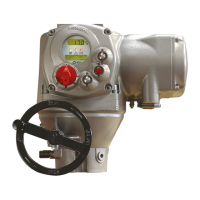5
BIFFI F01-2000 ELECTRIC ACTUATOR
INSTRUCTION AND OPERATING MANUAL
2�3 CHECKS TO BE PERFORMED BEFORE
INSTALLATION
• Make sure the valve to be motorised is the
appropriate one for coupling to the actuator.
• The electrical supply cables must be suitable
for the power rating (see the test certificate
that comes with the actuator).
• Gather the right tools for the assembly and
for setting the actuator controls.
If a long storage period has occurred,
beforereinstalling the actuator, please:
• Check the status of the O-ring seals.
• Check the installation of the plugs or cable
glands on the cable entries.
• Check whether the enclosure covers or the
actuator body are cracked or broken.
• Check the oil level in the actuator and top up
if necessary.
• Put the batteries back into place
(seeparagraph11.3, Maintenance - Lithium
battery change).
3 INSTALLATION
3�1 WORKING CONDITION
The standard actuators are suitable for
thefollowing environment temperatures:
-30°C +85°C (-22°F to +185°F)
Special versions are available for extreme
environment temperatures:
-40°C +70°C (-40°F to +158°F)
-55°C +70°C (-67°F to +158°F)
Note: only for Ex d or Ex d e versions, for
ambient temperature range, see the specific
attached addendum.
IMPORTANT
Check the “temperature environment range”
embossed on the nameplate, for the correct
utilisation with respect to the environment
temperature.
3�2 COUPLING BLOCK:
DISASSEMBLY FROM THE ACTUATOR
The bushing is delivered already assembled to
the drive sleeve, even when it is unmachined.
In order to perform the necessary machining,
remove the bushing from its housing. Remove
the fixing screws from the coupling block.
Actuator view from the coupling side, with the
bushing separated from the gearbox. Do not
lose the seal ring between the coupling block
and the gear reduction unit.

